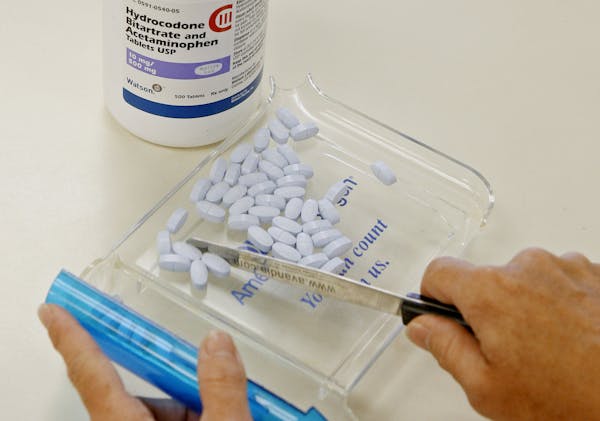The latest numbers are sobering: On average, 91 people a day die from an opioid-related overdose, according to the U.S. Centers for Disease Control and Prevention.
Minnesota is far from immune to the pain pill problem. Health officials say prescribed drugs, such as oxycodone and hydrocodone, were responsible for most of the state's opioid-involved deaths last year.
While doctors and legislators are taking steps to address the situation, there's another critical line of defense: loved ones who can spot the telltale signs of opioid addiction.
"A lot of family members will say, 'Oh, gosh, looking back, yeah, I see it.' Because it happens so gradually and so insidiously typically," said Dr. W. Michael Hooten, professor of anesthesiology at the Mayo Clinic in Rochester and an expert in pain medicine.
We asked Hooten and Dr. Charles Reznikoff, an addiction specialist at Hennepin County Medical Center, for advice on what to look for if you suspect someone you love is addicted to opioids:
1. A preoccupation with the drug
This can take several different forms, Hooten said. Some people may become very concerned or focused on the timing of their medication. With others, a lot of their daily activities revolve around the time when they take their medicine. They'll make sure nothing will interfere with that time — even if that means skipping important events.
They also may pay a lot of attention to ensuring that their refills aren't threatened in any way. And some people will want to increase their dosage to treat their pain.
2. Intoxication
Small pupils, slowed speech and heavy, drooping eyelids are classic signs that someone is intoxicated from opioid use, the doctors say.
"Two things make your pupils small — sunlight and opioids," Reznikoff said.
The person also might have trouble processing complex information. "It doesn't knock down the IQ points, but it takes somebody twice as long to do something that they would have done very quickly before," Hooten said.
People who are extremely intoxicated from opioids will do something called "nodding off" — falling asleep while seated upright, Reznikoff said. "They'll maintain their posture but they'll fall asleep. They often fall asleep in the middle of their sentence. They'll just drift off and then they'll wake up and finish their sentence as if nothing's wrong," he said.
3. Retreating from social events
Families may notice people becoming increasingly withdrawn and secretive about how they're using the drug — much like alcoholics who will try to hide their booze, Hooten said.
Even when they are surrounded by family, addicts will seek to distance themselves. "They're going to retreat to their room, close the door, and give the appearance of sleeping a lot," Reznikoff said. "They're not really sleeping — they're nodding off."
While people addicted to alcohol or cocaine often become loud or manic in their behavior, opioid addicts tend to be mellow. "These patients are going to be content to go off into a quiet room and just relax," he said. "They're not frantically on the computer, or going out to the bar and getting into fistfights. They're very low-key."
4. Withdrawal symptoms
"A patient of mine, his family observed that the first two days of every family vacation he was in his room alone, feeling sick," Reznikoff said. " 'How did he get the flu at the beginning of every family vacation?' they wondered. Well it wasn't the flu. It was withdrawal."
When addicts are cut off from their supply of opioids, they go through withdrawal for a couple of days. Symptoms include diarrhea or vomiting, sweating, large pupils, and goose bumps.
"They may be moving around a lot," Reznikoff continued. "They will feel anxious, irritable. They'll say they're in pain. Some people get headaches or abdominal pain or back pain."
5. Drug paraphernalia
Opioid users may swallow a pill. They may snort it. They may smoke it. Or they may inject it.
If they're smoking or injecting it, there will be a lot of paraphernalia around, Reznikoff said.
Look for needles, cotton balls, syringes and spoons. Spoons are often used to melt the drugs. The cotton balls, he explained, are used as a filter. "They'll have some of the drug melted in liquid form, and then they'll draw it into the needle through the cotton ball, believing that impurities are caught in the cotton."
Allie Shah • 612-673-4488
@allieshah

The 5 best things our food writers ate this week

A Minnesota field guide to snow shovels: Which one's best?

Summer Camp Guide: Find your best ones here

Lowertown St. Paul losing another restaurant as Dark Horse announces closing

